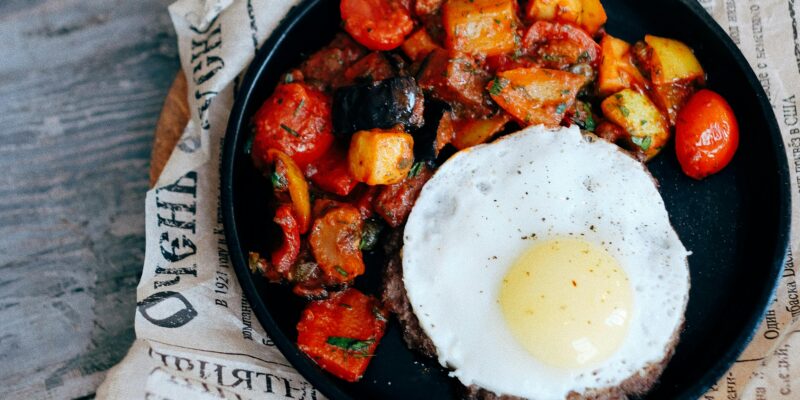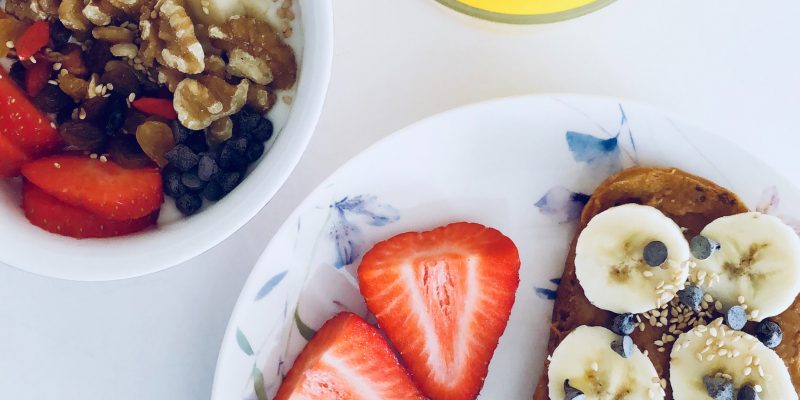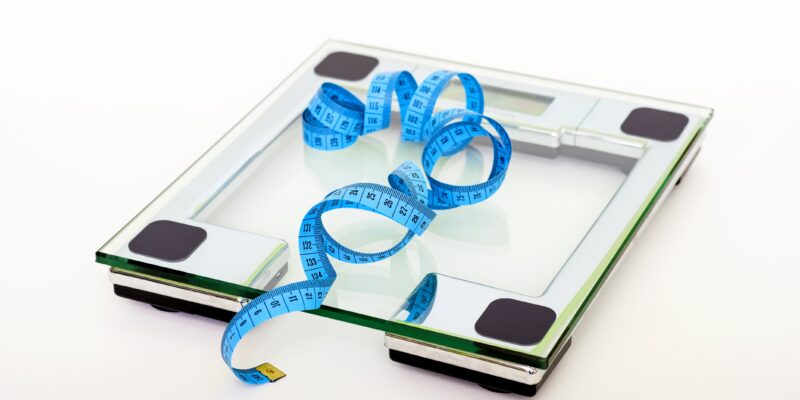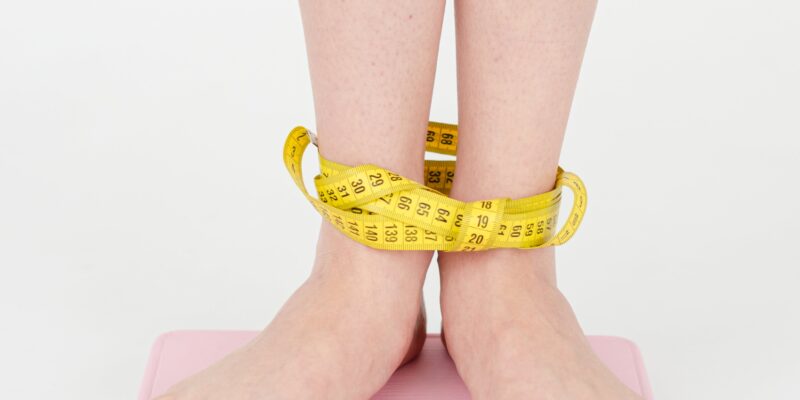Whether enjoyed plain or enhanced with toppings, oatmeal is a nutritious cornerstone in the dancer’s diet. As a complex carbohydrate, oatmeal offers sustained energy release, crucial for fueling intensive rehearsals and performances while helping to maintain stable blood sugar levels. Its high fiber content aids in digestive health, promoting a feeling of fullness. In this blog post, enjoy over 25 recipe and ingredient boosters for your oatmeal.
Read More...The Importance of Vitamin B12 for Dancers
Vitamin B12 plays an active role in many bodily functions— from your blood health and nerve functioning, to your growth and genetic makeup. Vitamin B12 also functions in the process of metabolism, supporting the breakdown and utilization of nutrients from food for energy. Since our bodies cannot produce vitamin B12, we must obtain it through our diet. In this blog post, we’ll explore why this vitamin is crucial for dancers, how to ensure an adequate intake and provide some delicious recipes to incorporate into your meal plan even if you’re a plant-based dancer.
Read More...30+ habits of The Healthy Dancer®
Becoming The Healthy Dancer® means challenging ideals— those dictating how dancers should and shouldn’t look, how much dancers should and shouldn’t train, what dancers should and shouldn’t eat, and how much dancers should and shouldn’t eat. Most importantly, it embodies the journey towards redefining this term: healthy. What are some characteristics of *healthy* dancers? In this blog post, we’re listing the most common among dancers who are actively supporting sustainable careers.
Read More...Salt for dancers: how much is too much?
Among the various nutrients, one that has garnered mixed reviews is salt. Many dancers fear salt. It’s not uncommon for dancers to go as far as restricting their salt intake altogether, fearing it will cause bloat and water retention. However, salt is an incredibly important mineral for a dancer’s body, and understanding its role can […]
Read More...How To Eat Healthy In College
College is an exciting time that brings about a newfound level of independence and autonomy. But for many college-aged dancers, limited time and financial resources can make the idea of fueling for performance stressful especially is residing in a dorm for a summer dance intensive or a year-round pre-professional program.
Read More...Food Variety- why dancers need more of it
Learning how to build a supportive eating routine is a tenet of The Healthy Dancer® — a key player in their physical, mental, and emotional well-being. In my work as a dietitian for dancers, we prioritize balanced meals to ensure adequate fueling patterns. Alongside this is aiming for a variety of foods. But what does […]
Read More...Performing again… even in motherhood
I did a thing… and it wasn’t something I expected to do… ever again. Nearly 15 years ago, I said goodbye to stage life. At the time, I was struggling with disordered eating and feeling stuck in my identity as a dancer. Dancing had always been a MAJOR part of my life, but a newfound […]
Read More...The Importance of Iron for Dancers
Iron is a notable mineral relied upon by athletes for performance success— so much so that the International Olympic Committee recommends iron screenings during health evaluations. Despite a dancer’s needs being comparable to those of athletes, iron remains overlooked. In a study of female ballet dancers, more than half were reported to be iron deficient. In this blog post, we will explore the paramount importance of iron for dancers and how it contributes to their overall performance and well-being.
Read More...Dealing with Food Disappointment
We’ve all been there – eagerly anticipating a delicious meal only to be met with disappointment. At this moment, do we keep eating? Is it “worth it?” Whether it’s a homemade dish that didn’t turn out as expected or a restaurant experience that fell short, dealing with culinary letdowns is a part of our food journey. For dancers who struggle with disordered eating, however, this disappointment is amplified. In this post, we’ll explore practical tips on how to cope with a disappointing food or meal.
Read More...What’s The Best Diet for A Dancer?
In pursuit of their performance, dancers are often swayed by the illusion of a “perfect” diet. But in the context of food, this can lead them down an unsustainable path. Rigid food rules create a cycle of guilt, anxiety, and stress at mealtimes. With a dancer’s risk of developing an eating disorder three times higher than that of the general person, it’s imperative to recognize the importance of nutrition for performance. In this blog post, we’ll uncover 5 lifestyle changes to help dancers optimize their plates or performance.
Read More...What Is A Ballet Body?
For dancers, a presumed “ideal body” formulates what many know to be the “aesthetic” of ballet. It often ignores what is healthy, and rather, embodies a cluster of privileges surrounding diet and weight— those rooted in white elitism. It has taken me years to find peace and neutrality with my body, let alone continue to dance with it. So when I hear from dancers who continue to experience weight stigma, “fat” talks, and comments in the studio, alarm bells sound. In this blog post, we’ll explore the impact of weight comments in the studio and on social media, and provide practical strategies to navigate these challenges.
Read More...Weight Loss for Dancers
A dancer’s desire to lose weight is the reality of an industry saturated with aesthetic ideals. But here’s the deal: as a clinician, it’s my ethical duty to educate dancers about the hard facts of not only dieting, but also, systemic fatphobia. Therefore, weight loss isn’t a priority for The Healthy Dancer®. Now, despite weight loss not being a priority for The Healthy Dancer®, it could be a symptom as you build a supportive relationship with food.
Read More...Your Mind-Body Connection: The Role of Food and Nutrition
For dancers, the mind-body connection plays a pivotal role in developing artistic expression. A dancer’s mind-body connection relies on more than just a balanced plate. In this blog post, we will explore the intricate relationship between food, nutrition, and the mind-body connection for dancers— welcoming The Healthy Dancer® Body of Evidence as a tool to build your mind-body connection.
Read More...Can Frozen Food Be Healthy?
For busy dancers, frozen foods might just be the saving grace of a post-performance recovery meal. But from a nutrition perspective, these can be hit or miss with higher-than-recommended sodium counts and questionable ingredients. We can, however, consider a few helpful tips to turn frozen meals into a nourishing option.
Read More...Alleviate Muscle Cramping: Strategies for Dancers
Muscle cramping commonly leads to discomfort for dancers, ultimately hindering performance. Proper training, rest, and warm-up routines are crucial, but how about nutrition? Are there meal-time interventions that dancers can make to prevent and alleviate muscle cramping? In this blog post, we’ll explore the answers to this question, along with key considerations for dancers to manage muscle cramping effectively.
Read More...Sustaining Healthy Habits with The Healthy Dancer®
The Healthy Dancer® encompasses a 6-step approach that does exactly this: guides dancers in building the behavioral changes needed to support their relationships with food and maintain a healthy body image. But even for seasoned professionals, the challenge isn’t just to make behavioral changes, it’s to sustain them. Let’s uncover the most common reasons why dancers struggle to sustain behavioral change— especially concerning food and body image, and how to overcome them.
Read More...What does it mean to be a Healthy Dancer?
Dance is an art form that demands immense physicality, mental focus, and creative expression. Behind this lies a unique and demanding lifestyle that is essential for dancers to maintain and excel in their craft. In this blog post, we will explore what it truly means to be a healthy dancer and why I’ve devoted my […]
Read More...Ideal Weight Charts for Dancers
Using a charting system such as ideal weight charts to determine a dancer’s performance potential is extremely harmful. Dancers have a three times higher risk of suffering from an eating disorder when compared to the general population. This article discusses what an Ideal Weight Chart for Dancers is and whether they’re helpful or harmful.
Read More...A Dancer’s Shopping Guide: Groceries
Navigating your grocery aisles can be intimidating. Endless options of any one type or brand of food can be daunting. As dancers continue to experience financial strain throughout the current global pandemic, access to quality food options is made even more stressful. But how can dancers continue to fuel optimally despite these obstacles? Here are 3 key steps…
Read More...How To Stop Eating When You Feel Full
Are you having difficulty honoring your fullness cues? Are you frustrated about constantly eating past a comfortable fullness? Do you find yourself “overeating” more times than not? In this post, we’ll discuss what it actually means to feel full after eating and how to regain the ability to feel when enough is actually enough.
Read More...





















